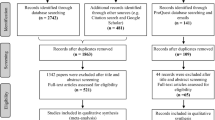Abstract
Analyses have suggested math anxiety is a multidimensional construct. However, previous behavioral genetic work examining math anxiety was unidimensional. Thus, the purpose of the present study was to examine different approaches for specifying behavioral genetic models of math anxiety as a multidimensional construct. Three models were compared: a unidimensional model, a three dimension multidimensional model, and a bi-factor model, which partitioned variance into one common factor shared across three dimensions of math anxiety and examined residual variance in each dimension. The best fitting model was a bi-factor AE model, which suggested moderate heritability of general math anxiety and that each dimension of math anxiety had unique etiological influences not accounted for by shared variance with the general math anxiety factor. Thus, while there was evidence of shared etiology, there was also evidence of some etiological distinction across dimensions of math anxiety. The results demonstrate the importance of taking into account the dimensionality of the scale when interpreting similarity across twins.



Similar content being viewed by others
References
Ashcraft MH, Ridley KS (2005) Math anxiety and its cognitive consequences: a tutorial review. In: Campbell JID (ed) Handbook of mathematical cognition. Psychology Press, New York, pp 315–327
Beilock SL, Willingham DT (2014) Ask the cognitive scientist—math anxiety: Can teachers help students reduce it? Am Educator 38:28–33
Chen J, Yu J, Li X, Zhang J (2015) Genetic and environmental contributions to anxiety among Chinese children and adolescents—a multi-informant study. J Child Psychol Psychiatry 56(5):586–594
Dowker A, Sarkar A, Looi CY (2016) Mathematics anxiety: what have we learned in 60 years? Front Psychol 7:508
Garcia S, Tully EC, Tarantino N, South S, Iacono WG, McGue M (2013) Changes in the genetic and environmental influences on trait anxiety from middle adolescence to early adulthood. J Affect Disord 151(1):46–53
Gierl MJ, Bisanz J (1995) Anxieties and attitudes related to mathematics in grades 3 and 6. J Exp Edu 63(2):139–158
Gregory AM, Eley TC (2007) Genetic influences on anxiety in children: what we’ve learned and where we’re heading. Clin Child Fam Psychol Rev 10(3):199–202
Hart SA, Logan JA, Thompson L, Kovas Y, McLoughlin G, Petrill SA (2016) A latent profile analysis of math achievement, numerosity, and math anxiety in twins. J Educ Psychol 108(2):181–193
Lau JY, Eley TC, Stevenson J (2006) Examining the state-trait anxiety relationship: a behavioral genetic approach. J Abnorm Child Psychol 34(1):19–27
Lukowski SL, DiTrapani J, Jeon M, Wang Z, Schenker VJ, Doran MM, Hart SA, Mazzocco MMM, Willcutt EG, Thompson LA, Petrill SA (2016) Multidimensionality in the measurement of math-specific anxiety and its relationship with mathematical performance. Learn Individ Differ. https://doi.org/10.1016/j.lindif.2016.07.007
Malanchini M, Rimfeld K, Shakeshaft NG, Rodic M, Schofield K, Selzam S, Dale PS, Petrill SA, Kovas Y (2017) The genetic and environmental aetiology of spatial, mathematics and general anxiety. Sci Rep 7:42218
Muthén LK, Muthén BO (1998–2011) Mplus user’s guide [computer software manual]. Los Angeles, CA
Ramirez G, Shaw ST, Maloney EA (2018) Math anxiety: past research, promising interventions, and a new interpretation framework. Educ Psychol 53(3):145–164
Scaini S, Belotti R, Ogliari A (2014) Genetic and environmental contributions to social anxiety across different ages: a meta-analytic approach to twin data. J Anxiety Disord 28(7):650–656
Suàrez-Pellicioni M, Nuñez-Peña MI, Colomé A (2016) Math anxiety: a review of its cognitive consequences, psychophysiological correlates, and brain bases. Cogn Affect Behav Neurosci 16(1):3–22
Suinn RM, Taylor S, Edwards RW (1988) Mathematics rating scale for elementary school students (MARS-E): psychometric and normative data. Educ Psychol Meas 48(4):979–986
van den Berg SM, Glas CA, Boomsma DI (2007) Variance decomposition using an IRT measurement model. Behav Genet 37(4):604–616
Wang Z, Hart SA, Kovas Y, Lukowski SL, Soden B, Thompson LA, Plomin R, McLoughlin G, Bartlett CW, Lyons IM, Petrill SA (2014) Who’s afraid of math? Two sources of genetic variance for mathematical anxiety. J Child Psychol Psychiatry 55(9):1056–1064
Wang Z, Shakeshaft N, Schofield K, Malanchini M (2018) Anxiety is not enough to drive me away: a latent profile analysis on math anxiety and math motivation. PLoS ONE 13(2):e0192072. https://doi.org/10.1371/journal.pone.0192072
Wood SG, Hart SA, Little CW, Phillips BM (2016) Test anxiety and a high-stakes standardized reading comprehension test: a behavioral genetics perspective. Merrill Palmer Q 62(3):233–251
Zheng Y, Rijsdijk F, Pingault JB, McMahon RJ, Unger JB (2016) Developmental changes in genetic and environmental influences on Chinese children and adolescent anxiety and depression. Psychol Med 46(9):1829–1838
Acknowledgements
The authors would like to thank Dr. Katherine Rhodes for her insightful comments on earlier versions of this manuscript. This work was supported by the Eunice Kennedy Shriver National Institute of Child Health and Human Development Grants HD038075, HD059215, and HD075460. S. Lukowski was supported in part by a grant from the National Science Foundation through the Graduate Research Fellowship Program, DGE-1343012.
Author information
Authors and Affiliations
Corresponding author
Ethics declarations
Conflict of interest
Sarah L. Lukowski, Jack DiTrapani, Nicholas J. Rockwood, Minjeong Jeon, Lee A. Thompson, Stephen A. Petrill declare they have no conflict of interest.
Informed consent
Informed consent was obtained from a parent/guardian of each of the child participants. All children provided informed assent to participate in the study.
Ethical approval
All procedures performed as a part of the study were in accordance with ethical standards and approved by the institutional review board.
Additional information
Publisher’s Note
Springer Nature remains neutral with regard to jurisdictional claims in published maps and institutional affiliations.
Edited by Deborah Finkel.
Rights and permissions
About this article
Cite this article
Lukowski, S.L., DiTrapani, J., Rockwood, N.J. et al. Etiological Distinction Across Dimensions of Math Anxiety. Behav Genet 49, 310–316 (2019). https://doi.org/10.1007/s10519-018-09946-3
Received:
Accepted:
Published:
Issue Date:
DOI: https://doi.org/10.1007/s10519-018-09946-3




